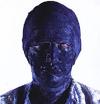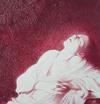Helnwein Monograph, the State Russian Museum, St. Petersburg – January 1, 1997
Retrospective, the State Russian Museum, St. Petersburg
THE HELNWEIN PASSION

I'll never forget the sensation I had at the unveiling of Gottfried Helnwein's "Kindskopf" in the Russian Museum. And not just because this enormous canvas (six metres in height, four in breadth), well-known from reproductions, seemed to operate in a whole new way in the real, quasi-monumental space of the museum's "Concrete Hall", originally intended for the demonstration of gigantic sculptural compositions. I realised that I was looking at the inner content of this innovative picture from a whole new point of view.
The Japan Times – November 9, 1996
One-man show at Hokkaido's Petersburg Museum, 1996
PROVOKATIVE EMOTIONS IN YOUR FACE
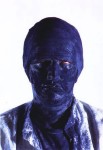
The Gottfried Helnwein seen on the poster advertising his show and the Gottfried Helnwein viewed in person seem to be a study in contradictions. With his head bandaged and eyes literally pierced by two forks, the poster Helnwein shatters glass with his seemingly torturous cries. In person, Helnwein's taut skin is unblemished; his personality, approachable and warm. But as he begins to talk, it becomes clear that he is indeed the creator of the madman.
Rheinisches Landesmuseum Bonn – January 1, 1996
Rheinisches Landesmuseum Bonn, 1996
MADONNA

Gottfried Helnwein's artistic and intellectual approach is to aim quite subtly at producing a crucial feeling of insecurity and a concomitant change of consciousness in the viewer, by using seemingly familiar or usual images that have a certain amount of tradition and an apparently well known composition.
Helnwein exhibition catalogue, Andreas Mäckler – November 30, 1995
One Man Show, Museum of Modern Art, Otaru, 1996
SELFPORTRAIT
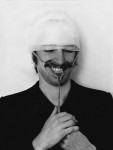
"The reason why I took to doing self-portraits", Gottfried Helnwein said in a 1990 interview, "and why I have been presenting my own persona from the very start, lay in a kind of substitution for the self. There is nothing of an autobiographical or therapeutic nature on show. It tells you nothing about me personally. I don't mean me at all: I just use myself because I am always available as a model. All I mean to present is a human being, pure and simple." The bandaged head became a cliché that was repeatedly misunderstood. Even Mick Jagger once asked, albeit with a laugh: "Will you paint me with bandages?"
Helnwein show at the Museum of Modern Art Otaru, Japan, catalogue – November 30, 1995
One-man Show at the Museum of Modern Art Otaru, Japan, 1996
THE METAPHORICAL PRINCIPLE OF GOTTFRIED HELNWEIN
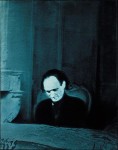
The works of Gottfried Helnwein are technically classified as hyper-realism (surpassing super-realism) and at first glance are practically indistinguishable from photographs. Though realistic in terms of technique, most of Helnwein's works are characterized by metaphorical implications.
Among his works, for example, is a painting of a man blindfolded with a bandage around his head. Featured in magazines and newspapers worldwide, looking at this painting may have caused people to feel its unheard cry.
Throughout most of Helnwein's work is the basic principle of realism laced with metaphor. Viewed in this light, this basic principle can be considered, in a sense, metaphorical under the guise of realism. On the contrary, photographs by Helnwein look like paintings with implications.
Included in all of Gottfried Helnwein's work, this basic principle demonstrates a reflection of the aesthetics of popular culture and irony, and represent Helnwein's major outlook on the world.
Gottfried Helnwein is endowed with perfect pitch and distinguished sense of contemporary issues.
As a painter whose art deals with issues confronting human society, Helnwein creates a new standard of measuring modernism.
Prestel, Munich - New York, catalogue – November 30, 1994
It's Only Rock and Roll, 1995
IT'S ONLY ROCK AND ROLL
Curator of 20th Century Art, Phoenix Art Museum
IT'S ONLY ROCK AND ROLL
Rock and Roll Currents in Contemporary Art.
The portraits of Hendrix, Joplin, and Lennon are particulary stirring because their ghostlike treatment translates as a poetic and humble tribute to major creative forces whose lives were tragically cut short. As exemplified by the paintings of Helnwein, the purpose of a contemporary rock and roll portrait may extend well beyond biographical signification to stimulating reflection upon larger issues of social or political consequence.
The Gazette, Monreal – November 30, 1993
One-man show, Centre International d'Art Contemporain de Montreal, Quebec
CENT JOURS BEGINS NINTH SEASON
To inaugurate the new exhibition space, which has to be one of the most dramatic in the city, Gosselin chose a powerful show of black-and-white photos by the Viennese-born German artist Gottfried Helnwein. Helnwein's work is everything that Annie Leibovitz's, shown last spring at the Montreal Museum of Fine Arts, is not. While both shoot celebrities - Helnwein's subjects include Keith Richards, Michael Jackson, Mick Jagger, William S.Burroughs, and an extremly wasted Andy Warhol - Helnwein's work is concentrated on the Psychological rather than on the gimmicky and the theatrical.
CAMERA International – December 1, 1992
"Faces", one-man show in the Goethe-Institute Paris
GOTTFRIED HELNWEIN

In fact Gottfried Helnwein made his name by spectacular performances, among them are self mutilations or simulacra of violence inflicted on himself. The violence is often concentrated on the eyes. The artist takes to bandaging the head which deprives the individual of all visual relations with the outside world. An obvious paradox on the part of an artist's whole life and work is closely linked with sight, to apply himself to representing, in various forms, impediments and problems of sight. Undoubtedly the scope of his projects is not limited to the sole artistic domain. His art also takes on an obvious historic dimension. Like a good number of artists of his generation, those born after the war, be they writers, painters, film makers or photographers, Gottfried Helnwein feels intense guilt at belonging to a part of Europe with such an unbearable past.
Art News, New York – November 1, 1992
One-man show at Modernism Gallery, San Francisco, 1992
SAN FRANCISCO, GOTTFRIED HELNWEIN, MODERNISM

Gottfried Helnwein follows the lead of his older Viennese contemporaries Arnulf Rainer and Hermann Nitsch in staging masquerades of suffering for the camera. He is the principal performer in his tableaux, some of which he translates from photograph into painting. Helnwein's first San Francisco show at the Modernism, came well past the moment when art seemed a fit vehicle for facile protestations of disgust at 20th-century history, especially those twisted with irony.
"Malerei muss sein wie Rockmusik" – 21. September 1992
Interview by Andreas Mäckler, 1992
GOTTFRIED HELNWEIN IM GESPRÄCH MIT ANDREAS MÄCKLER

Gottfried Helnwein im Gespräch mit Andreas Mäckler. Die Interviews mit Gottfried Helnwein fanden statt am 13./14. Juli und wurden am 21./22. September 1990 fortgesetzt
